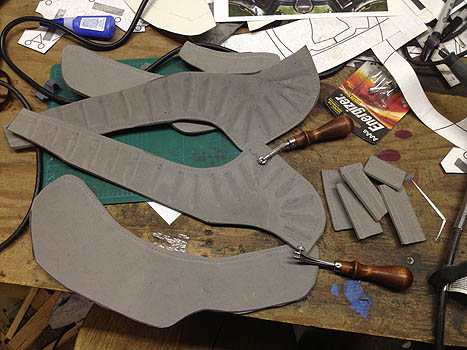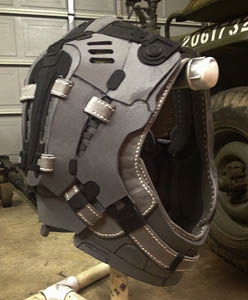Materials & Tools
1/4" or 1/2" EVA foam
Woven Surveyor String (Home Depot or Lowe's)
Leather Sewing Needles
Overstitch Tool
Sharpie
Process
If the strap or simulated leather item is supposed to be thick or look quilted, then you'll want to use your dremel tool to carve a channel or valley for the stitching to sit in. The pieces shown to the left do not have channels cut, but they do have some quilting that's been simulated by using the dremel sanding drum.
To get very consistant stitches, roll the Overstitch tool along where you want the stitching to go, usually 1/4" to 1/2" from the edge of the foam. My overstitch wheel is too narrow/close for my stitches, so I use a Sharpie to mark every other mark on the foam. |

EVA sculpted and stitch locations marked
|
Sew the strapping using Woven Surveyor String and Leather Sewing Needles. The EVA foam is soft enough that you will not have to punch each hole like you do with leather.
I find it helpful to put a drop of superglue on the knots so they don't work out. You can also drizzle some superglue along the back of the stitching to help the string stay down. |

EVA stitched with Surveryor's String
|
| Here's the stitched strapping & undervest attached to the armor. You can see that I've glued strap keepers, etc over the strapping. |

Simulated Leather Straps installed on prop
|
| To give the EVA foam the look of worn leather, use the blunt tip on your Heat Knife to dabble divets into areas of the surface. You can also lightly draw lines along the foam to give the look of creases in the leather. |

Finished Simulated Leather
|




